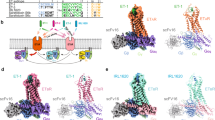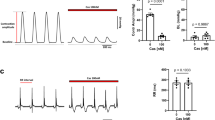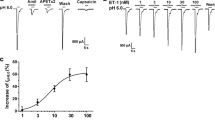Abstract
VOLTAGE-SENSITIVE ion channels play fundamental roles in the regulation of cardiac function by various neurotransmitters1,2. Endothelins3 have strong positive inotropic4 and chronotropic5 effects, for which recent studies have implicated various intracellular mechanisms6,7. However, very little is known about the underlying ion-channel regulation by the peptide. We report here that endothelin-1 consistently hyperpolarizes the membrane and shortens the duration of the action potential in mammalian atrial myocytes, leading to suppression of electrical excitability of the heart. Endothelin-1, but not endothelin-3, inhibited the L-type calcium current by decreasing cyclic AMP accumulation and activated the muscarinic potassium current by stimulating a pertussis toxin-sensitive GTP-binding protein. Consistent with these results, endothelin-1 strongly reduced the heart rate when it was increased by β-adrenoceptor stimulation. These effects were blocked by an ETA (endothelin-1-selective) receptor-selective antagonist, BQ123 (refs 8–11). The ETA receptor-mediated regulation of cardiac ion channels gives new insight into our understanding of the physiological and pathophysiological roles of endothelins in the control of cardiac function.
This is a preview of subscription content, access via your institution
Access options
Subscribe to this journal
Receive 51 print issues and online access
$199.00 per year
only $3.90 per issue
Buy this article
- Purchase on Springer Link
- Instant access to full article PDF
Prices may be subject to local taxes which are calculated during checkout
Similar content being viewed by others
References
Ono, K., Delay, M., Nakajima, T., Irisawa, H. & Giles, W. Nature 340, 721–724 (1989).
Reuter, H. A. Rev. Physiol. 41, 413–424 (1979).
Yanagisawa, M. et al. Nature 332, 411–415 (1988).
Ishikawa, T., Yanagisawa, M., Kimura, S., Goto, K. & Masaki, T. Am. J. Physiol. 255, H970–H973 (1988).
Ishikawa, T., Yanagisawa, M., Kimura, S., Goto, K. & Masaki, T. Pflügers Arch. ges. Physiol. 413, 108–110 (1988).
Masaki, T., Yanagisawa, M. & Goto, K. Med. Res. Rev. 12, 391–421 (1992).
Aramori, I. & Nakanishi, S. J. biol. Chem. 267, 12468–12474 (1992).
Ihara, M. et al. Life Sci. 50, 247–255 (1992).
Arai, H., Hori, S., Aramori, I., Ohkubo, H. & Nakanishi, S. Nature 348, 730–732 (1990).
Sakamoto, A. et al. J. biol. Chem. 268, 8547–8553 (1993).
Sakurai, T. et al. Nature 348, 732–735 (1990).
Franco-Cereceda, A., Matran, R., Lou, Y.-P. & Lundberg, J. M. Acta physiol. scand. 138, 539–547 (1990).
Tohse, N., Hattori, Y., Nakaya, H., Endou, M. & Kanno, M. Br. J. Pharmac. 99, 437–438 (1990).
Hartzell, H. C. & Simmons, M. A. J. Physiol., Lond. 389, 411–422 (1987).
Pfaffinger, P. J., Martin, J. M., Hunter, D. D., Nathanson, N. M. & Hille, B. Nature 317, 536–538 (1985).
Kim, D. Circ. Res. 69, 250–255 (1991).
Sakamoto, A. et al. Biochem. biophys. Res. Commun. 178, 656–663 (1991).
Inoue, A. et al. Proc. natn. Acad. Sci. U.S.A. 86, 2863–2867 (1989).
Tanaka, T. et al. Molec. Pharmac. 45, 724–730 (1994).
Ishikawa, T. et al. Circ. Res. 69, 918–926 (1991).
Hori, S., Komatsu, Y., Shigemoto, R., Mizuno, N. & Nakanishi, S. Endocrinology 130, 1885–1895 (1992).
Hilal-Dandan, R., Urasawa, K. & Brunton, L. L. J. biol. Chem. 267, 10620–10624 (1992).
Vogelsang, M., Broede-Sitz, A., Schäfer, E., Zerkowski, H.-R. & Brodde, O.-E. J. cardiovasc. Pharmac. 23, 344–347 (1994).
Wennmalm, A., Benthin, G., Karwatowska-Prokopczuk, E., Lundberg, J. & Petersson, A.-S. J. Physiol., Lond. 435, 163–173 (1991).
Reid, J. J., Lieu, A. T. & Rand, M. J. Eur. J. Pharmac. 194, 173–181 (1991).
Hamill, O. P., Marty, A., Neher, E., Sakmann, B. & Sigworth, F. J. Pflügers Arch. ges. Physiol. 391, 85–100 (1981).
Ono, K. & Giles, W. R. J. Physiol., Lond. 436, 195–217 (1991).
Author information
Authors and Affiliations
Rights and permissions
About this article
Cite this article
Ono, K., Tsujimoto, G., Sakamoto, A. et al. Endothelin-A receptor mediates cardiac inhibition by regulating calcium and potassium currents. Nature 370, 301–304 (1994). https://doi.org/10.1038/370301a0
Received:
Accepted:
Issue Date:
DOI: https://doi.org/10.1038/370301a0
This article is cited by
-
Plasma big endothelin-1 predicts new-onset atrial fibrillation after surgical septal myectomy in patients with hypertrophic cardiomyopathy
BMC Cardiovascular Disorders (2019)
-
Cardiac Pacemaker Cells Generate Cardiomyocytes from Fibroblasts in Long-Term Cultures
Scientific Reports (2019)
-
Endothelin-1 Decreases Excitability of the Dorsal Root Ganglion Neurons via ETB Receptor
Molecular Neurobiology (2017)
-
Improvement in cardiac function of diabetic rats by bosentan is not associated with changes in the activation of PKC isoforms
Molecular and Cellular Biochemistry (2006)
-
Regulation of the muscarinic K+ channel by extracellular ATP through membrane phosphatidylinositol 4,5‐bisphosphate in guinea‐pig atrial myocytes
British Journal of Pharmacology (2005)
Comments
By submitting a comment you agree to abide by our Terms and Community Guidelines. If you find something abusive or that does not comply with our terms or guidelines please flag it as inappropriate.



